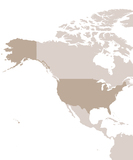USA
USA
Refugees:
130,000–140,000 mostly Jewish refugees from the German-speaking areas.
Political situation:
Federal and presidential republic; economic crisis; high unemployment. Emphasis on national interests, closed foreign policy. December 1941: Entry into the war on the side of the Allies.
Conditions of entry:
Visa requirement; restrictive quota system, depending on the country of origin; compulsory guarantee from a U.S. citizen ("affidavit"), from July 1941 two guarantees. Exceptions for academics. Entry possible on a visitor's visa. From 1940, programme for accepting prominent individuals at risk. Work permit.
The USA was the most important host country. Many victims of persecution sought refuge when the situation in Europe became increasingly desperate from 1938. Living conditions in the United States were good for refugees, thanks in part to the support of aid organisations. Nevertheless, many emigrants had to earn a living outside their original occupation and suffered from their loss of status. Academics, by contrast, had a good chance of continuing in their career. For some artists, the film industry in Hollywood offered a lucrative field of work. Many emigrants volunteered for the U.S. Army after the USA entered the war. Large numbers of refugees only discovered later that they had been monitored by the FBI since their arrival.


